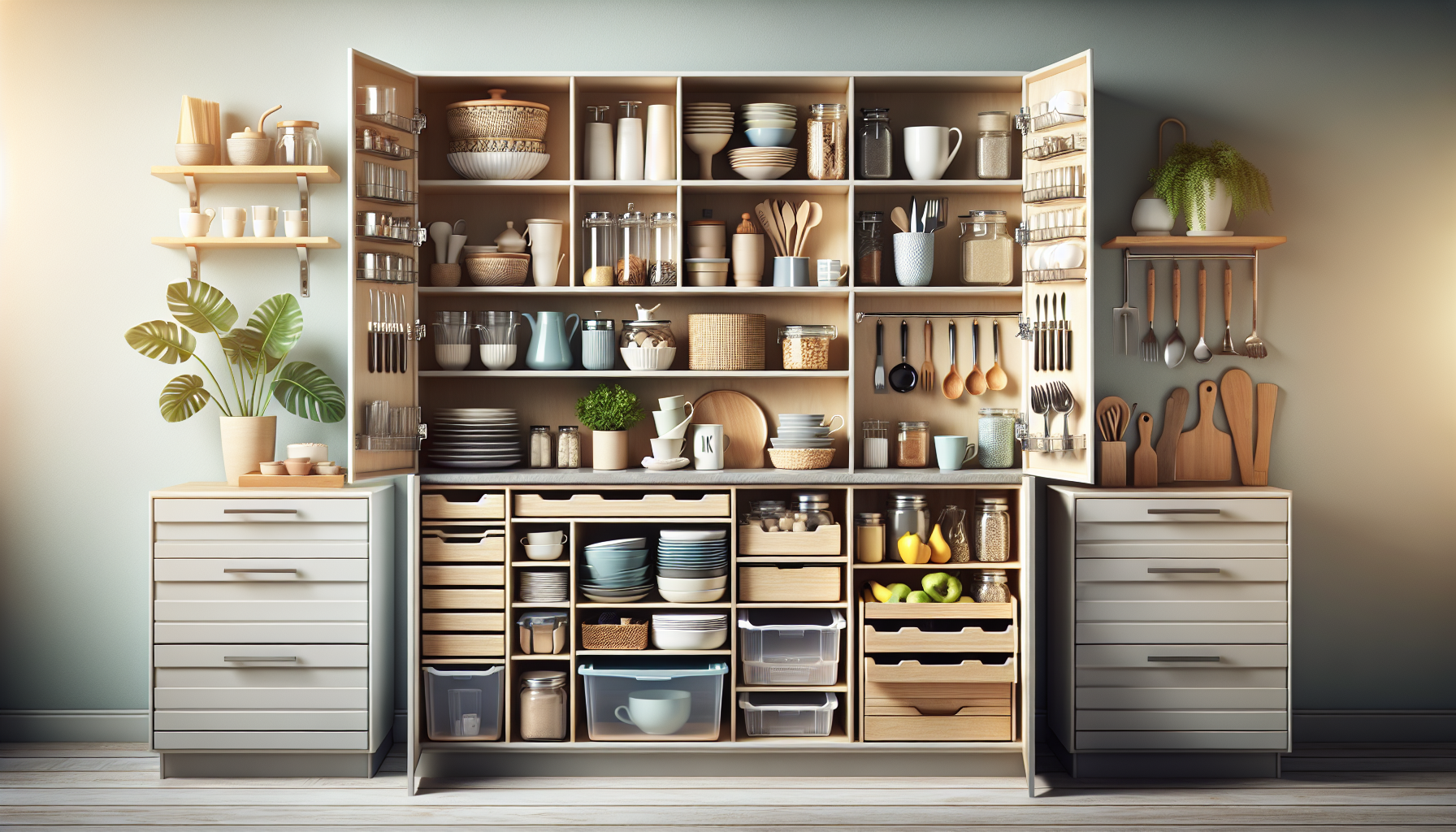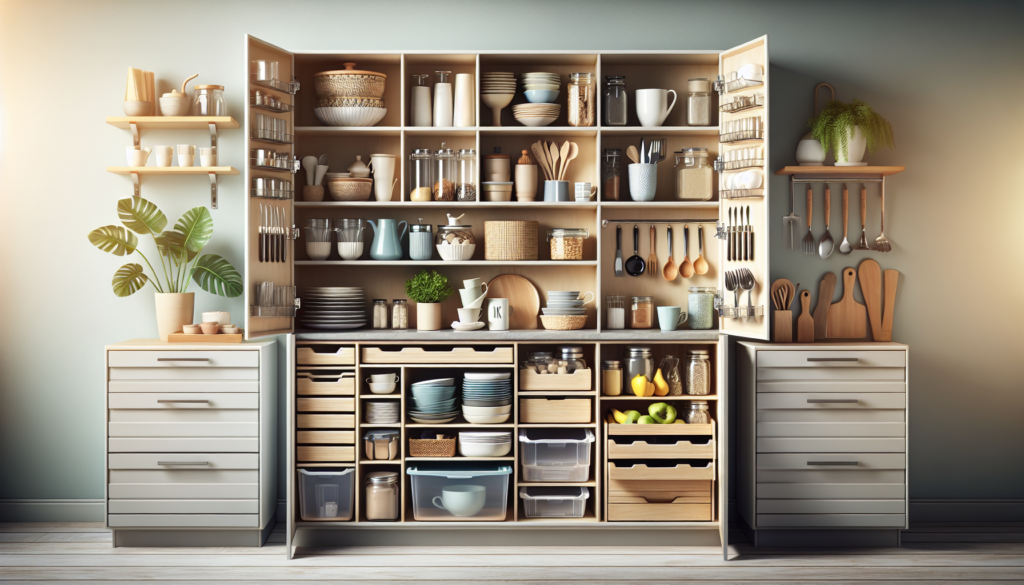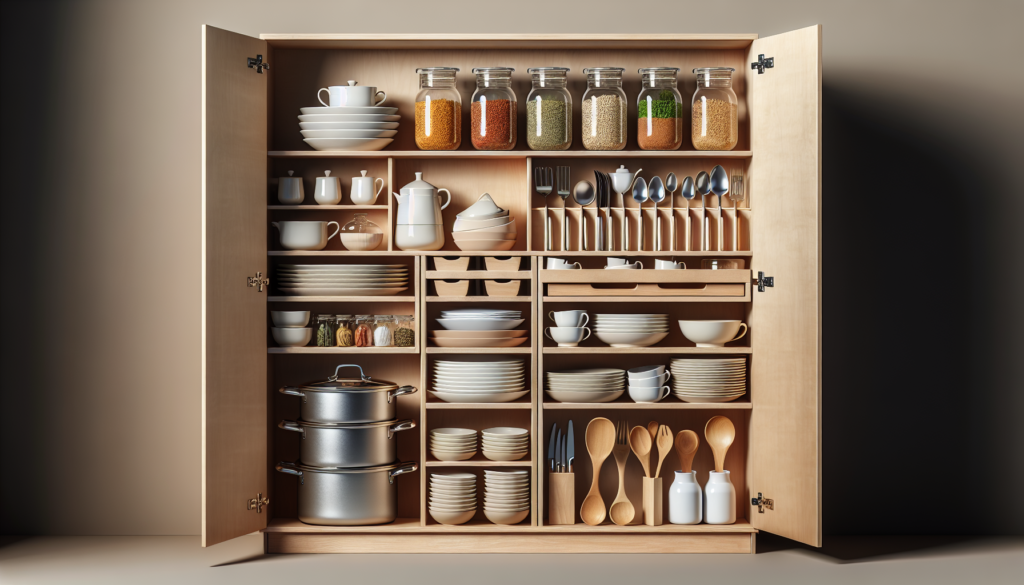
Are your cabinets overflowing and in desperate need of organization? Look no further! This essential guide to cabinet organization is here to help you transform your cluttered chaos into a neatly organized space. With a variety of tips and tricks, you’ll learn how to maximize your storage, utilize different organizing tools, and create a system that works for you. Say goodbye to rummaging through piles of pots and pans or losing track of your favorite spices. Get ready to turn your cabinets into a well-organized haven that will make your life just a little bit easier.

Assessing Your Needs
Identifying the Purpose of Your Cabinet
Before diving into the world of cabinet organization, it’s important to first identify the purpose of your cabinet. Are you looking to store kitchen utensils, office supplies, or maybe even cleaning products? Understanding the specific function of your cabinet will help you determine the most effective organization methods.
Evaluating the Items You Want to Store
Once you’ve determined the purpose of your cabinet, it’s time to evaluate the items you want to store. Take a good look at what you currently have and consider whether each item is still necessary or if it’s time to let go. This is a great opportunity to declutter and get rid of items you no longer need, creating more space and making organization easier in the long run.
Determining the Size and Type of Cabinet Needed
Next, you’ll need to determine the size and type of cabinet needed to accommodate your items. Measure the dimensions of the space where the cabinet will be placed to ensure a proper fit. Consider the height, width, and depth of the cabinet, as well as any specific features or compartments that may be beneficial for organizing your items. Keeping these factors in mind will help you make an informed decision when it comes time to choose a cabinet.
Clearing Out and Decluttering
Emptying the Entire Cabinet
Now that you’ve assessed your needs and determined the type of cabinet you require, it’s time to start the organization process. Begin by emptying the entire cabinet. Yes, that means taking out every single item and placing them on a clear surface. This step allows you to get a clear visual of the items you have and makes it easier to sort them into different categories.
Sorting Items into Keep, Donate, or Discard Piles
With all your items laid out in front of you, it’s time to start sorting. Create three separate piles: keep, donate, and discard. Go through each item one by one and decide whether you truly need to keep it, if it’s something that can be donated to someone in need, or if it’s simply taking up space and should be discarded. Be honest with yourself during this process and remember, the goal is to create a well-organized cabinet.
Purging Unnecessary Items and Maximizing Space
Once you’ve sorted your items into the three piles, it’s time to take action. Remove the items you’ve decided to donate or discard from your workspace and find appropriate ways to dispose of them. As for the items you’re keeping, think about how you can maximize the space in your cabinet. Are there any items you can consolidate or store more efficiently? Consider investing in storage bins, dividers, or racks to help you make the most of the available space.
Planning and Preparing the Cabinet
Measuring the Cabinet’s Dimensions
Now that you’ve cleared out and decluttered your cabinet, it’s time to move on to the planning and preparation stage. Start by measuring the dimensions of your cabinet, taking note of the height, width, and depth. This information will be invaluable when you begin searching for the right organizational tools to fit your specific needs.
Checking for Any Needed Repairs
While you’re in the planning and preparation phase, take a moment to inspect your cabinet for any needed repairs. Are there any loose hinges, broken handles, or damaged shelves? Now is the perfect time to address these issues and ensure your cabinet is in good working order before you start organizing. Repairing any damages will prevent potential accidents and make your overall organization project smoother.
Cleaning and Sanitizing the Cabinet
Before you start organizing your items back into the cabinet, it’s essential to clean and sanitize the space. Remove any dust, dirt, or debris that may have accumulated. Wipe down the surfaces with a gentle cleaner or disinfectant to keep your items clean and prevent the spread of germs. A clean cabinet not only looks better but also creates a fresh and inviting space for your belongings.

Choosing Organizational Tools
Determining the Appropriate Storage Solutions
With your cabinet clean and ready, it’s time to choose the right organizational tools for your items. Consider the size, shape, and quantity of the items you’re storing. Will you benefit from storage bins, dividers, or racks? Choose organizational tools that are sturdy and durable, ensuring they can withstand the weight of your items and secure them in place. The right storage solutions will help maintain the order and accessibility of your cabinet.
Selecting Bins, Dividers, or Racks Based on Items
When selecting storage bins, dividers, or racks, keep in mind the items you have categorized and sorted. Look for bins that are deep enough to store taller items and dividers that can be adjusted to accommodate various sizes. Racks can be beneficial for holding lids, baking sheets, or cutting boards vertically, saving space and making them easily accessible. By tailoring the storage solutions to your specific items, you can maximize the efficiency of your cabinet.
Considering Adjustable or Stackable Options
If you anticipate needing flexibility in your cabinet organization, consider choosing adjustable or stackable organizational tools. Adjustable dividers, for example, can be moved or removed as your needs change over time. Stackable storage bins can be a great space-saving solution for items that are used less frequently or have different shapes and sizes. These options allow for customization and adaptability, ensuring your cabinet can evolve along with your organizational needs.
Grouping and Categorizing Items
Sorting Items into Logical Categories
As you begin to organize your items back into the cabinet, one of the most effective strategies is to sort them into logical categories. Group similar items together, such as spices in one section, baking supplies in another, and cooking utensils in another. This makes it easier to locate specific items when you need them and helps maintain order within the cabinet.
Organizing Items by Frequency of Use
In addition to grouping items by category, consider organizing them based on frequency of use. Store frequently used items at eye level or within easy reach for convenience. Items that are used less frequently can be placed on higher or lower shelves. By organizing items in this way, you’ll save time and effort searching for what you need, ultimately making your daily routines more efficient.
Choosing a System That Makes Finding Items Easier
When organizing your items, choose a system that makes finding items easy. Consider using open bins or clear containers for frequently used items, as they allow for quick visibility and easy retrieval. Utilize drawer dividers to separate and organize small items like office supplies or utensils. The goal is to create a system that not only maximizes available space but also simplifies the process of locating and accessing your items.
Utilizing Cabinet Spaces Effectively
Using Vertical Space with Shelf Risers or Hooks
To make the most of your cabinet space, look for opportunities to utilize vertical space. Shelf risers can help you double the storage capacity of your shelves by creating additional levels. Hooks can be installed on the inside of cabinet doors to hang items like measuring cups, pot holders, or cleaning tools. These simple additions make use of otherwise wasted space and allow for a more comprehensive organization system.
Maximizing the Cabinet Door for Additional Storage
Don’t overlook the potential storage space on the inside of your cabinet doors. Utilize adhesive hooks or magnetic strips to hang lightweight items like measuring spoons, oven mitts, or even small cleaning supplies. Consider attaching a small whiteboard or chalkboard on the inside of the door to jot down grocery lists or important reminders. The cabinet door presents a prime opportunity to maximize your storage options and keep frequently used items easily accessible.
Installing Pull-Out Shelves or Lazy Susans for Accessibility
For those items that can easily get lost in the back of your cabinet, consider installing pull-out shelves or lazy susans. These organizational tools allow for easy access to items stored in the deepest parts of your cabinet. With a simple pull or spin, you can easily retrieve what you need without having to rummage through the entire shelf. Investing in these accessibility-enhancing options will make your cabinet organization more efficient and user-friendly.
Labeling and Identifying Items
Using Clear and Consistent Labels
Labels are a crucial part of any well-organized cabinet. Use clear and consistent labels to ensure you and others understand where items belong. Choose labels that are easy to read and understand at a glance. Whether you opt for handheld label makers or printable labels, take the time to create a labeling system that works for you and your household.
Labeling Bins, Shelves, or Drawers
While labeling your items is important, don’t forget to label the storage containers themselves. Use labels on bins, shelves, or drawers to indicate the specific category of items they contain. This will make it easy to locate items and maintain the overall organization of your cabinet. Consider using labels that are removable or easily replaceable so that you can adapt your organization as needed.
Adding Visual Cues for Easy Identification
In addition to text-based labels, consider adding visual cues to help with easy identification. This can be especially useful for children or individuals who may have difficulty reading labels. Use colored stickers or pictures to represent different categories or types of items. A blue sticker could indicate cleaning supplies, while a red sticker could represent baking supplies. Adding these visual cues will enhance the overall organization and accessibility of your cabinet.
Maintaining and Cleaning
Establishing a Regular Cleaning Routine
To keep your cabinet organization at its best, establish a regular cleaning routine. Set aside time every few weeks to wipe down the surfaces, dust the shelves, and ensure everything is tidy. By incorporating this routine into your regular cleaning schedule, you’ll maintain the cleanliness and order of your cabinet, making it a pleasure to use.
Wiping Down Surfaces and Removing Dust
During your regular cleaning routine, be sure to wipe down all surfaces of the cabinet. Use a damp cloth or mild cleaner to remove any dirt or spills. Don’t forget to dust the shelves and the interior corners. Maintaining a clean cabinet not only keeps everything looking fresh but also prolongs the lifespan of your items by preventing grime buildup.
Reassessing and Reorganizing Periodically
As time goes on, your cabinet organization needs may change. Periodically reassess and reorganize your cabinet to ensure it continues to meet your evolving needs. Take note of any areas that could be improved or optimized. Don’t be afraid to switch up the placement of items or try out new organizational tools. By regularly reassessing and making adjustments, you’ll maintain an organized cabinet that grows with you.
Customizing for Specific Needs
Tailoring the Organization to Your Lifestyle
Each person’s lifestyle and preferences are unique, so it’s essential to tailor your cabinet organization to what works best for you. Consider your daily routines, habits, and personal preferences when deciding how to arrange and categorize items. If you love baking, dedicate a specific section of the cabinet to baking supplies. If you frequently use certain spices, create a designated area for them. Customizing your cabinet organization will make it more efficient and enjoyable in the long run.
Adapting the Cabinet for Specific Items
In addition to customizing your organization for your lifestyle, consider adapting the cabinet itself to accommodate specific items. For example, if you have a large collection of tall pans, remove a shelf from your cabinet to create extra height. If you frequently use your tablet or phone while cooking, install a charging station inside the cabinet for easy access and charging. These small adaptations can make a big difference in the functionality and convenience of your cabinet.
Incorporating Personal Preferences and Style
Finally, don’t forget to incorporate your personal preferences and style into your cabinet organization. Choose colors, patterns, or designs that bring you joy and reflect your personal aesthetic. Consider adding decorative touches, such as shelf liners, door handles, or even a small plant, to make your cabinet feel more inviting. When your cabinet organization reflects your personal style, you’ll be more motivated to maintain its order and enjoy the process of utilizing your items.
Troubleshooting and Problem-Solving
Addressing Common Organization Challenges
Even with the most thorough planning and preparation, you may encounter common organization challenges along the way. Lack of space, difficulty in finding specific items, or inadequate storage can all be obstacles to achieving a well-organized cabinet. When faced with these challenges, think creatively and consider alternative solutions. Look for ways to utilize unused spaces, such as the back of cabinet doors or the inside of cabinet lids. Explore different storage options or consider purging items that are no longer necessary. Remember, there are always solutions to overcome any organization hurdles.
Finding Solutions for Limited Space
Limited space is a common challenge in many cabinets, especially in smaller kitchens or bathrooms. When faced with limited space, think vertically and make use of every inch. Look for stackable storage containers, utilize shelf risers to create additional levels, or install hooks on the inside of the cabinet door to hang items. If your cabinet space is still insufficient, consider adding additional storage solutions outside the cabinet, such as wall-mounted shelves or a hanging pot rack.
Coping with Odd-Shaped or Large Items
Odd-shaped or large items can sometimes pose a challenge when it comes to cabinet organization. To cope with these items, consider alternative storage solutions. Look for specialized storage containers or organizers designed for specific items such as wine bottles, cutting boards, or baking pans. If the shape or size of an item doesn’t fit well within the cabinet, consider storing it in a separate designated space, such as a pantry or utility closet. Don’t be afraid to think outside the box and find creative solutions for these unique items.
In conclusion, organizing your cabinet requires careful assessment of your needs, clearing out and decluttering, planning and preparing the cabinet, choosing the right organizational tools, grouping and categorizing items, utilizing cabinet spaces effectively, labeling and identifying items, maintaining and cleaning, customizing for specific needs, and troubleshooting and problem-solving. By following these comprehensive steps and incorporating your personal touch, you can transform your cabinet into a functional and organized space that enhances your daily routines. Take the time to invest in cabinet organization, and you’ll reap the benefits of a clutter-free and efficient home.